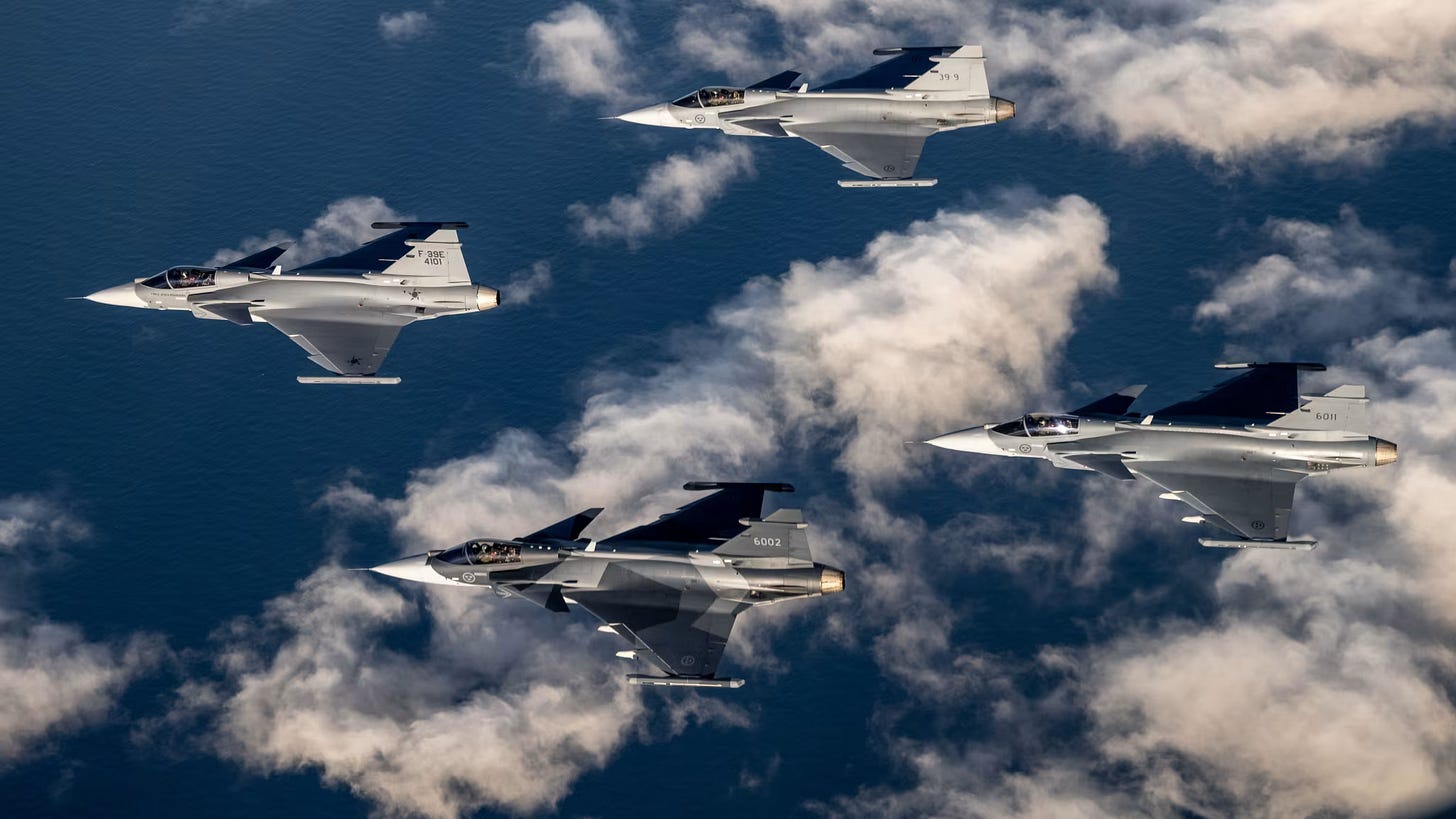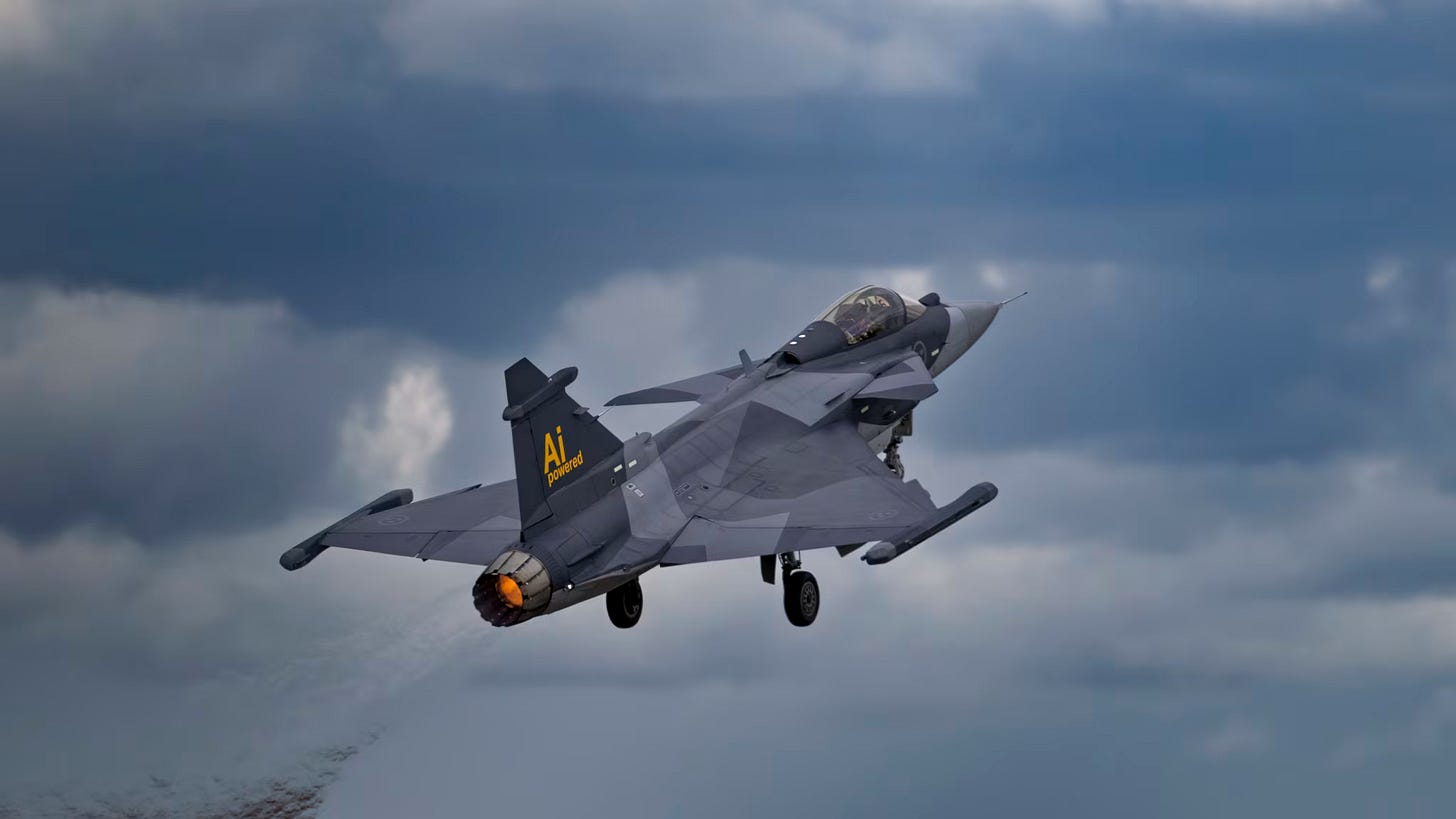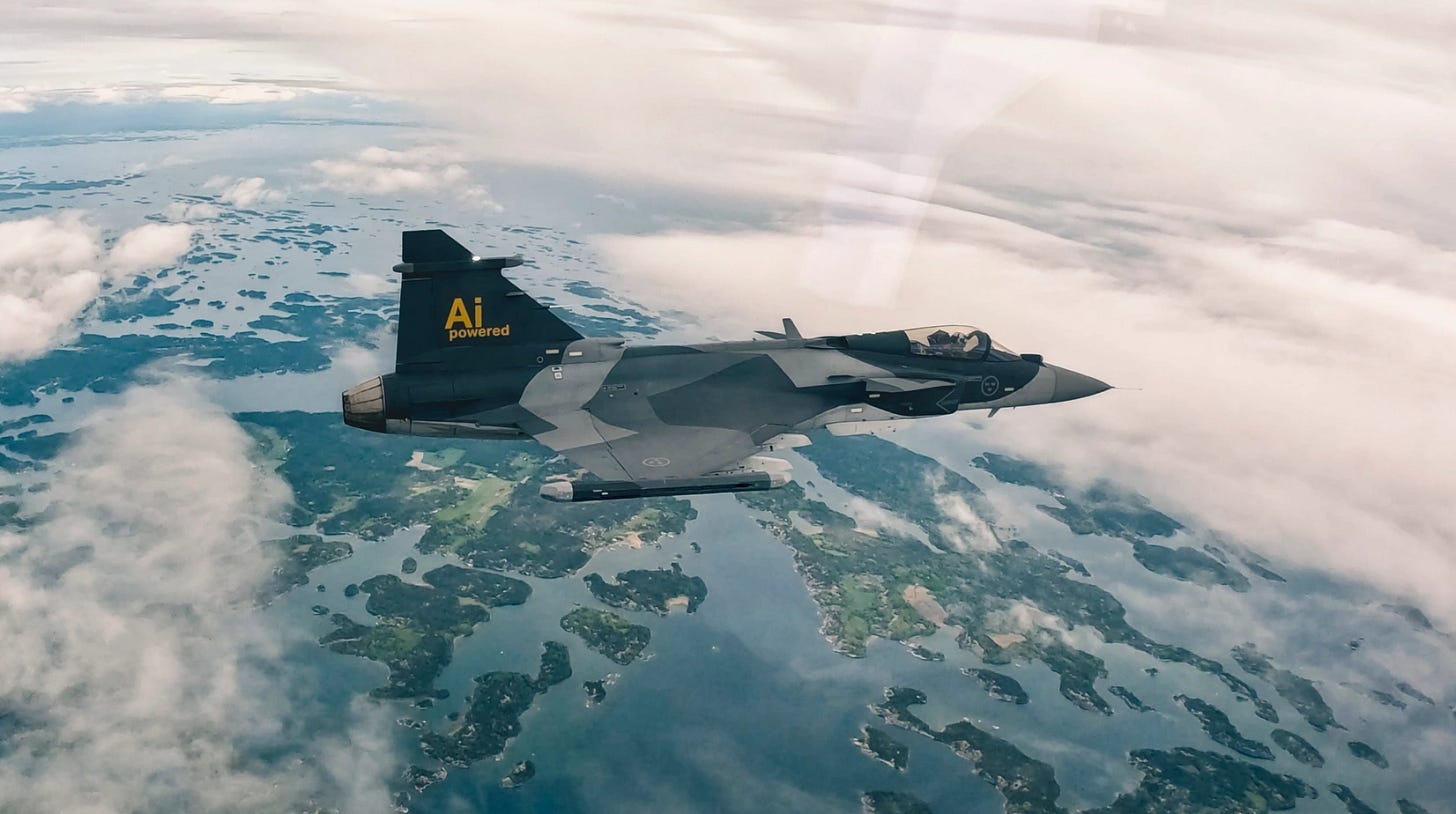AI is now being used in Beyond Range Air-to-Air Combat
The Engineer's Perspective is a reader-supported publication. Sign and up and subscribe to see more in-depth Aerospace/Aeronautical Analysis!
Content:
Table of Contents:
Introduction and Overview
Historical Development
Implications
Specifications
Concept of Operations
Systems Engineering
Systems Engineering Requirements
Calculations (Optional)
Conclusion
References
Introduction and Overview
Saab’s Gripen E fighter is currently undergoing advanced testing with an artificial intelligence (AI) agent, Centaur, for long-range air-to-air combat. This initiative is part of Sweden’s Project Beyond and involves collaboration between Saab and Germany’s Helsing. The integration of AI into the Gripen E is designed to enhance autonomous decision-making in beyond-visual-range (BVR) engagements, offering a potential leap forward in air combat operations and represents a significant advancement in military aviation providing opportunities to improve decision-making speed, adaptability, and survivability in complex air-to-air engagements, if successfully leveraged to increase pilot effectiveness, reduce cognitive load, and rapidly adapt to evolving aerial threats, Gripen E despite not having the label of 5th generation, can be positioned at the forefront of modern air combat due to its avionics capabilities.
Historical Development
The integration of artificial intelligence into military aviation has progressed rapidly over the past decade, driven by advances in machine learning, sensor fusion, and autonomous systems. Early applications of AI in the defense sector focused on simulation-based training, decision support tools, and unmanned aerial vehicles (UAVs). These initial efforts demonstrated the potential for AI to enhance situational awareness, optimize mission planning, and automate routine or high-risk tasks.
Saab’s involvement in human-machine collaboration predates Project Beyond, with the company investing in research and development of open-architecture avionics. This modular approach to system design enabled the rapid incorporation of new technologies—such as advanced sensors, data links, and AI algorithms—without the need for extensive airframe modifications. Open-architecture systems have been a cornerstone of Saab’s philosophy, allowing for continuous upgrades and adaptation as operational requirements evolve.
The Centaur program, developed in partnership with Helsing and funded by the Swedish government, represents a significant leap forward in the operationalization of AI within crewed fighter aircraft. Preparatory work for Centaur began six months prior to its first test flight in May 2025, involving rigorous simulation-based testing, algorithm refinement, and integration with the Gripen E’s mission systems. The program’s accelerated timeline reflects both the maturity of Saab’s open-architecture platform and the growing urgency to address emerging threats in the aerial domain.
Unlike earlier experimental platforms—which often required substantial modifications or operated only in controlled test environments—Centaur was integrated into the operational Gripen E with minimal changes to the aircraft’s hardware. This approach enabled rapid transition from simulation to live flight testing, setting a new benchmark for the deployment of AI-enabled capabilities in front-line fighters. The success of this integration distinguishes the Gripen E as a pioneering platform in the field of AI-supported air combat, providing valuable lessons for future aircraft development and international defense collaboration.
Implications
The deployment of AI-supported fighters like the Gripen E with Centaur AI carries significant and far-reaching implications for air forces and defense strategies globally:
Enhanced Combat Effectiveness:
AI agents are capable of processing vast amounts of sensor data from multiple sources—including radar, infrared, and electronic support measures—at speeds far exceeding human capability. This enables faster detection, identification, and prioritization of threats in dynamic air combat environments. AI can execute complex maneuvers, calculate optimal engagement angles, and manage multiple simultaneous engagements, potentially shifting the balance in air-to-air combat by increasing both lethality and survivability. With AI’s ability to anticipate adversary moves and adapt tactics in real time, air forces can respond more effectively to evolving threats.Pilot Workload Reduction:
Modern air combat requires pilots to manage a high volume of information and make rapid decisions under stress. By automating routine and complex tasks—such as sensor fusion, threat assessment, and initial maneuver planning—AI systems allow pilots to focus on mission-critical decisions and overall tactical management. This not only improves pilot performance and reduces fatigue but also enhances safety and mission success rates, especially in high-intensity or multi-aircraft scenarios.Rapid Adaptation:
AI systems can be retrained and updated much more quickly than human crews can be retrained, enabling continuous improvement and adaptation to new threats, tactics, or technologies. Software-based AI agents can be upgraded remotely, incorporating new data, threat libraries, or operational lessons learned from recent engagements. This agility ensures that the platform remains effective even as adversaries evolve their own tactics or deploy new technologies.Strategic Deterrence:
For smaller air forces, such as Sweden’s, AI-enabled fighters can serve as a force multiplier, helping to offset numerical or resource disadvantages against larger adversaries. By maximizing the capabilities of each aircraft and pilot, AI integration can enhance overall deterrence, making it riskier and more costly for potential adversaries to challenge national airspace or interests. This strategic benefit is particularly important for nations seeking to maintain credible defense postures with limited resources.Influence on Future Platforms:
The operational experience and lessons learned from integrating Centaur AI into the Gripen E will directly inform Sweden’s next-generation fighter programs. Successful deployment and validation of AI-supported combat operations may set new benchmarks for performance, interoperability, and adaptability. Furthermore, these advancements could influence international defense procurement, as allied and partner nations look to adopt similar AI-enabled systems to maintain technological parity or superiority in future air combat environments.
Concept of Operations
Stakeholders:
Swedish Air Force: The primary end user, responsible for operational deployment, pilot training, and integrating AI-enabled tactics into existing doctrine.
Saab and Helsing (developers): Jointly responsible for developing, integrating, testing, and continually upgrading the AI agent and its supporting systems.
Defense procurement organizations (FMV): Oversee project funding, requirements validation, compliance with defense standards, and eventual certification for operational use.
Potential export customers: International air forces and defense organizations interested in acquiring advanced AI-enabled combat capabilities for their own fleets.
Purpose:
The integration of AI into the Gripen E aims to significantly enhance air-to-air combat effectiveness by increasing engagement speed, improving adaptability against advanced threats, and reducing the cognitive burden on pilots. This enables more effective mission execution, even in highly contested or rapidly evolving operational environments.
Operational Overview:
Pre-Flight:
The AI agent undergoes extensive training and validation in simulated environments, exposing it to a wide range of combat scenarios, adversary tactics, and environmental conditions.
Simulation data is used to refine AI algorithms and ensure robust performance before integration into the aircraft.
Once validated, the AI agent is installed into the Gripen E’s mission systems, with comprehensive ground testing to confirm compatibility and safety.
Flight Operations:
During beyond-visual-range (BVR) engagements, Centaur continuously collects and processes data from the aircraft’s sensors and external sources (e.g., AEW&C platforms).
The AI autonomously identifies, prioritizes, and tracks multiple targets, executing dynamic maneuvers to optimize positioning and survivability.
Centaur provides the pilot with real-time firing cues and engagement recommendations, or, in fully autonomous mode, can execute weapon release sequences according to mission rules.
The system adapts to changing tactical situations, such as the appearance of new threats or loss of communications, ensuring mission continuity.
Post-Flight:
Data collected during test or operational flights is thoroughly analyzed to assess system performance, identify areas for improvement, and update AI models as needed.
Feedback from pilots and mission debriefs is incorporated into the iterative development process, fostering continuous enhancement of the AI’s capabilities.
Key Capabilities:
Autonomous target acquisition and engagement: Ability to independently detect, classify, and engage hostile aircraft with minimal pilot intervention.
Dynamic maneuver execution: Real-time calculation and execution of evasive or offensive maneuvers based on threat analysis and mission objectives.
Real-time adaptation: Continuous learning and adjustment to new adversary tactics, electronic warfare measures, and environmental changes.
Seamless human-machine collaboration: Designed to augment pilot situational awareness and decision-making, with intuitive interfaces and the ability for pilots to override or direct AI actions as needed.
The Gripen E equipped with Centaur AI is engineered to operate in contested airspace, leveraging both advanced machine intelligence and human judgment. This approach aims to maximize combat effectiveness, enhance survivability, and provide a technological edge in modern aerial warfare. The concept of operations emphasizes flexibility, adaptability, and continuous improvement, ensuring the system remains effective against evolving threats and mission requirements.
Systems Engineering
System Objectives:
Primary Functions: The system is designed to provide autonomous support during beyond-visual-range (BVR) combat, assisting pilots by analyzing complex tactical situations and making rapid threat assessments. It will serve as a decision support tool, offering recommendations and, when appropriate, executing maneuvers or engagements autonomously to enhance mission effectiveness and survivability.
Key Operational Capabilities: The system must be capable of fusing real-time data from multiple sources, including onboard sensors, external platforms, and intelligence feeds, to create a comprehensive and accurate operational picture. It should enable autonomous maneuvering, allowing the aircraft to respond dynamically to evolving threats. Additionally, the system must support rapid software updates to incorporate new algorithms, threat libraries, and mission profiles as they become available.
Mission Requirements: The system must be able to engage and manage multiple aerial threats simultaneously, prioritizing targets and coordinating with other assets as needed. It should maintain operational effectiveness under degraded communications, including situations where external command-and-control links are lost or jammed. Furthermore, the system should be designed to support both crewed and uncrewed platforms, ensuring flexibility for future force structures.
Performance Goals: The primary performance objectives are to increase the probability of successful engagements, reduce pilot cognitive workload by automating routine and complex tasks, and minimize the time required from threat detection to engagement decision.
Operating Conditions:
Environmental Parameters: The system must operate reliably in all weather conditions, including rain, snow, fog, and extreme temperatures, as well as during both day and night missions.
Operational Constraints: The system should be capable of independent operation, ensuring continued functionality and mission success even if external command-and-control is unavailable or compromised.
Infrastructure Requirements: The system must be fully compatible with existing Gripen E support infrastructure, including ground-based maintenance, diagnostic tools, and logistical support systems.
Maintenance Conditions: The system should require only routine software and hardware checks, with built-in self-diagnostic capabilities to identify and report faults, enabling efficient maintenance and minimizing aircraft downtime.
Expected Opposition/Challenges:
Potential Threats: The system must be designed to counter advanced enemy fighters equipped with sophisticated avionics and weapons, as well as electronic warfare measures intended to disrupt or deceive onboard systems. It should also be resilient to cyber attacks that may target software integrity or data links.
Countermeasures: To address these threats, the system will employ secure, encrypted data links for all communications, implement redundancy in critical decision-making processes, and support rapid retraining of AI models to adapt to new or evolving adversary tactics.
Design Considerations:
Modularity for Upgrades: The system architecture will be modular, allowing for the integration of new hardware components or software functionalities without major redesigns.
Scalability for Future AI Agents: The design will support the addition of future AI agents or expanded capabilities, ensuring that the platform remains relevant as technology advances.
Interoperability with Allied Systems: The system will adhere to open standards and protocols to ensure seamless communication and coordination with allied and coalition forces during joint operations.
Cost-effectiveness: Throughout its lifecycle, the system will be engineered for cost-effectiveness, balancing advanced capability with affordability in both acquisition and long-term operation.
Verification and Validation:
Flight and Simulation Testing: The system will undergo extensive simulation-based testing, followed by live flight trials, to evaluate performance across a range of operational scenarios and threat environments.
Performance Benchmarking: Regular benchmarking against human pilots and existing systems will be conducted to validate the system’s effectiveness, efficiency, and reliability.
Acceptance Criteria: Clearly defined acceptance criteria, based on mission outcomes such as engagement success rates, system reliability, and pilot workload reduction, will guide the evaluation process.
Certification for Operational Use: Upon successful completion of testing and validation, the system will be certified for operational deployment by relevant aviation and defense authorities, ensuring it meets all required safety and performance standards.
Systems Engineering Requirements
Functional Requirements
The system shall autonomously process and fuse data from multiple onboard and external sensors—including radar, infrared, and electronic support measures—to accurately identify, classify, and prioritize potential targets in real time.
The system shall generate and provide real-time maneuver and engagement recommendations to the pilot, factoring in threat assessments, rules of engagement, and mission objectives to optimize tactical decisions.
The system shall operate effectively in both fully autonomous mode—where it can execute tasks independently—and in pilot-directed mode, where it supports pilot inputs and can be overridden or directed as needed.
The system shall support both simulated training (using virtual scenarios and data) and live-fire training environments, enabling comprehensive pilot preparation and system validation.
Physical Requirements
The system shall be designed to fit within the existing avionics bays of the Gripen E without requiring structural modifications or additional space allocation.
The system shall not exceed predefined weight and power consumption limits, ensuring no adverse impact on aircraft performance, payload, or endurance.
The system shall utilize materials and components that are fully compatible with the current aircraft systems, including electromagnetic compatibility and thermal management standards.
Environmental Requirements
The system shall maintain full operational capability across the entire temperature and humidity envelope specified for the Gripen E, including extreme cold and heat.
The system shall remain functional and reliable at all operational altitudes, from ground level to the aircraft’s service ceiling.
The system shall be designed to resist electromagnetic interference (EMI) and operate reliably in environments with high levels of electronic activity or jamming.
Maintenance Requirements
The system shall support rapid and secure software updates, allowing for new features, threat libraries, and AI models to be deployed with minimal downtime.
The system shall require routine diagnostic checks that can be performed as part of standard maintenance cycles, with clear procedures for ground crews.
The system shall include built-in fault detection and reporting mechanisms, providing timely alerts and detailed diagnostics to maintenance personnel.
Interface Requirements
The system shall integrate with the Gripen E’s human-machine interface, presenting information to the pilot in an intuitive and actionable format.
The system shall support secure, high-speed data exchange with both onboard and offboard sensors, as well as with command and control assets, using encrypted communication protocols.
The system shall be interoperable with allied communication and data-sharing protocols, supporting joint and coalition operations.
Safety and Reliability Requirements
The system shall comply with all relevant aviation safety standards, including fail-safe and fail-operational requirements.
The system shall incorporate redundancy for all critical functions, ensuring continued operation in the event of hardware or software failures.
The system shall actively monitor for failure modes and implement mitigation strategies, such as graceful degradation or automated reversion to manual control.
Design Considerations
The system shall be modular in design, allowing for straightforward hardware and software upgrades as technology evolves or mission requirements change.
The system shall be scalable, supporting the integration of future AI capabilities or additional sensor inputs with minimal reengineering.
The system shall ensure interoperability with both existing and planned future platforms, including other aircraft and ground-based systems.
The system shall be cost-effective in terms of both acquisition and lifecycle operation, minimizing total ownership costs for operators.
Verification and Validation
The system shall undergo comprehensive simulation and live flight testing to validate performance under a range of operational scenarios and threat environments.
The system shall meet clearly defined performance acceptance criteria, including detection accuracy, response time, and reliability metrics.
The system shall be certified for operational deployment by relevant aviation authorities following successful completion of all testing and evaluation phases.
Conclusion
The integration of AI agents like Centaur into the Saab Gripen E marks a significant step forward in the evolution of air combat. By combining rapid data processing, autonomous decision-making, and human oversight, this system enhances both the survivability and effectiveness of modern fighters. As testing progresses, the lessons learned are expected to shape not only Sweden’s next-generation aircraft but also broader trends in military aviation worldwide.
References
Helsing AI agent successfully completes Saab Gripen E test flight.
In first, Saab tests AI-enabled combat capability on Gripen jets
Saab and Helsing pit AI-piloted warplane against real fighter pilot
The Engineer's Perspective is a reader-supported publication. To receive new posts and support my work, consider becoming a free or paid subscriber.



